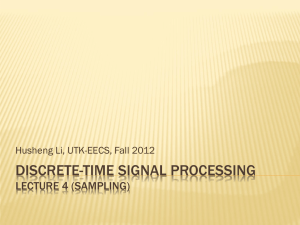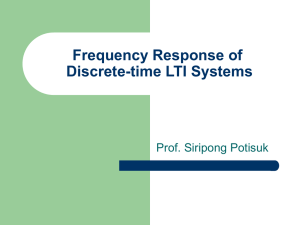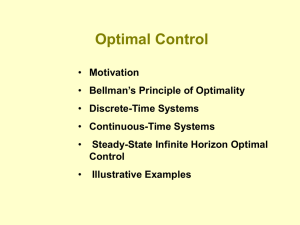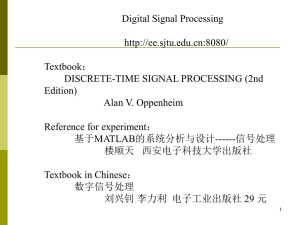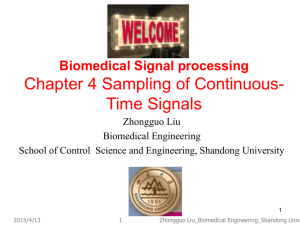Discrete Time Systems - Faculty of Computing, Engineering and
advertisement
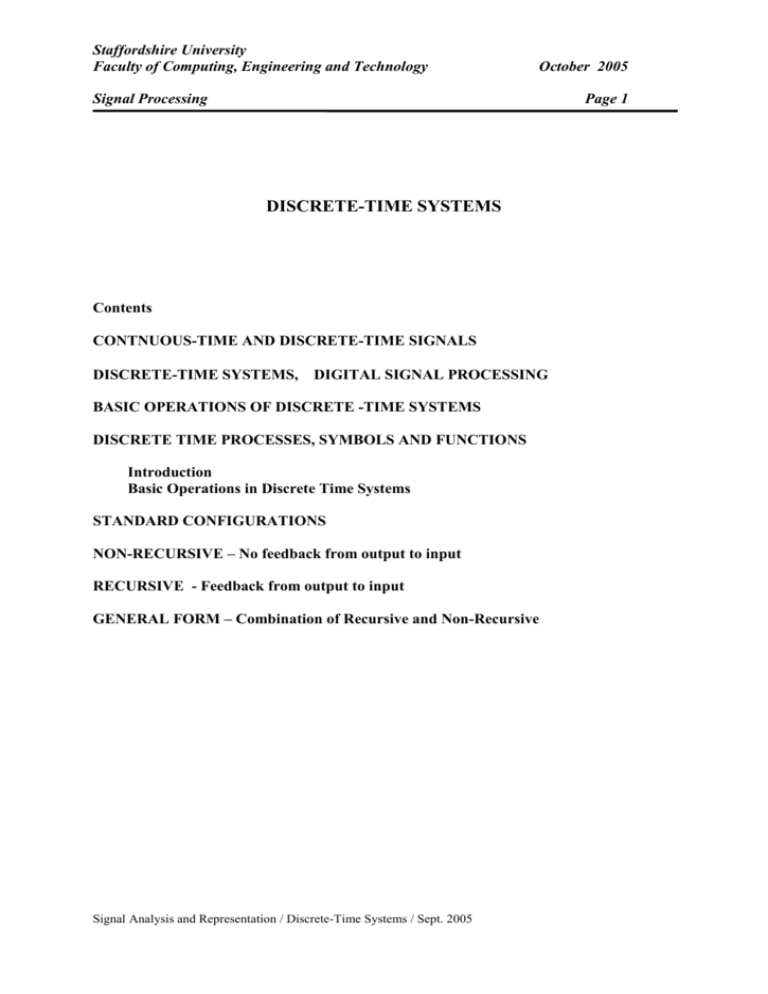
Staffordshire University
Faculty of Computing, Engineering and Technology
October 2005
Signal Processing
Page 1
DISCRETE-TIME SYSTEMS
Contents
CONTNUOUS-TIME AND DISCRETE-TIME SIGNALS
DISCRETE-TIME SYSTEMS,
DIGITAL SIGNAL PROCESSING
BASIC OPERATIONS OF DISCRETE -TIME SYSTEMS
DISCRETE TIME PROCESSES, SYMBOLS AND FUNCTIONS
Introduction
Basic Operations in Discrete Time Systems
STANDARD CONFIGURATIONS
NON-RECURSIVE – No feedback from output to input
RECURSIVE - Feedback from output to input
GENERAL FORM – Combination of Recursive and Non-Recursive
Signal Analysis and Representation / Discrete-Time Systems / Sept. 2005
Staffordshire University
Faculty of Computing, Engineering and Technology
October 2005
Signal Processing
Page 2
DISCRETE-TIME SYSTEMS
CONTNUOUS-TIME AND DISCRETE-TIME SIGNALS
A Continuous-Time or analogue signal is one which is defined at every point in an interval.
v(t)
AREA
t1
t2
BASE
A Discrete-Time signal is one which is defined only at discrete times (Instantaneous values).
Such a sequence of values arises for example from the process of sampling a continuous-time
signal.
Discrete-time
value
v(nTS)
t
0
0
1
TS
2
2TS
3
3TS
4
4TS
5
5TS
6
6TS
v(nTS) are the discrete time values or instantaneous values of v(t) at the instants nTS, where
TS is the sampling interval.
Signal Analysis and Representation / Discrete-Time Systems / Sept. 2005
Staffordshire University
Faculty of Computing, Engineering and Technology
October 2005
Signal Processing
Page 3
DISCRETE-TIME SYSTEMS,
DIGITAL SIGNAL PROCESSING
Discrete-time signals, denoted by x[n] for example, are signals defined only at discrete times.
In practice a discrete-time signal is often formed by sampling a continuous-time signal at
fixed intervals of time, TS, where TS is the sampling interval. This sampling forms a sequence
of (instantaneous) values denoted by x(nTS).
TS is the sampling interval, and n is the ‘sample number’
The discrete-time signal is encoded as a digital, binary signal representing the discrete-time
signal, denoted eg as x[n], ie x[n] ≡ x(nTS).
The conversion from an analogue to digital signal by sampling and encoding is called
analogue-to-digital conversion (ADC).
A digital-to-analogue converter (DAC) converts a digital signal to analogue, ie y[n] to y(t).
An overall block diagram is illustrated below.
Analogue
x[n]
x(t)
Low
Pass
Filter
ADC
Digital
y[n]
Digital Signal
Proc.
DSP
Signal Analysis and Representation / Discrete-Time Systems / Sept. 2005
Analogue
DAC
Low
Pass
Filter
y(t)
Staffordshire University
Faculty of Computing, Engineering and Technology
October 2005
Signal Processing
Page 4
Example
A signal v(t) = Vsinωt is sampled at a rate fS, starting at time t = 0, as illustrated below. Note
that in this example there are 8 samples per cycle.
v(2TS)
v(t)
V
Sample values of v(t) at t = n TS.
v(TS)
0
Time t
-V
Sample
Pulses
TS
The sampled output is v(nTS). How do we calculate v(nTS)?
v(nTS) are instantaneous values of v(t) at times t = nTS.
Since v(t) = Vsinωt, at times t = nTS we may write: v(nTS) = Vsin(ω nTS).
Now, since
2
, where T is the periodic time of the input signal, then,
T
2nTs
v(nTs ) V sin
T
Alternatively,
2nf
v(nTs ) V sin
fs
(Either form can be useful).
Signal Analysis and Representation / Discrete-Time Systems / Sept. 2005
Staffordshire University
Faculty of Computing, Engineering and Technology
October 2005
Signal Processing
Page 5
Ts
f
1
T
fs 8
2n
n
v(nTs ) V sin
V sin
8
4
In this example, with 8 samples per cycle,
Calculating and tabulating values over 1 cycle:
n
0
1
2
3
4
5
6
7
n
4
0
4
2
4
3
4
4
4
5
4
6
4
7
4
V(nTS)
0
0.7071V
V
0.7071V
0
-0.7071V
-V
-0.7071V
n
V sin
4
Note that the sampled sequence v(nTS) represents the amplitude or instantaneous values of
v(t) at the sampling instants.
Signal Analysis and Representation / Discrete-Time Systems / Sept. 2005
Staffordshire University
Faculty of Computing, Engineering and Technology
October 2005
Signal Processing
Page 6
BASIC OPERATIONS OF DISCRETE -TIME SYSTEMS
DISCRETE TIME PROCESSES, SYMBOLS AND FUNCTIONS
Introduction
In discrete time or digital signal processing, discrete time values of a signal, usually in the
form of binary numbers, are processed in a similar way to continuous time signals.
Often the discrete time signal represents a continuous time signal, derived through a process
of sampling and analogue-to-digital conversion, as illustrated below.
y[n]
x[n]
Input
x(t)
ADC
Discrete Time
Process
DAC
Output
y(t)
Sampling Pulse
Sample Rate fS
Sampling Interval TS.
The input and output signals are analogue or continuous time signals. The signals x[n] and
y[n] are discrete time signals derived through sampling and ADC.
Analogue-to digital conversion will be covered in a separate section. Some basic operations
in discrete time systems are presented below.
Basic Operations in Discrete Time Systems
Some basic building blocks used in the ‘Discrete Time Process’ part of the above diagram are
presented next.
Delay
x[n]
TS
x(nTS)
Signal Analysis and Representation / Discrete-Time Systems / Sept. 2005
x[n – 1]
x((n – 1)TS)
Staffordshire University
Faculty of Computing, Engineering and Technology
October 2005
Signal Processing
Page 7
A delay, TS introduces a delay equal to the sampling interval (ie TS)
We can think of this as ‘the current output is the previous input’.
TS
Example
x[n]
t = nTS
x(nTS)
n
TS
Delayed by TS
x[n – 1]
x((n – 1)TS)
t = nTS
n
Delay elements may be cascaded thus:
TS
x[n]
TS
x[n – 1]
TS
x[n – 2]
3 stages of delay
Signal Analysis and Representation / Discrete-Time Systems / Sept. 2005
x[n – 3]
Staffordshire University
Faculty of Computing, Engineering and Technology
Signal Processing
October 2005
Page 8
Addition of a Constant
x[n]
x[n] + a
a
TS
a
x[n] + a
t = nTS
n
Summation of Sequences
a[n]
b[n]
c[n]
y[n] = a[n] + b[n] + c[n] + d[n] + e[n]
d[n]
e[n]
Signal Analysis and Representation / Discrete-Time Systems / Sept. 2005
Staffordshire University
Faculty of Computing, Engineering and Technology
October 2005
Signal Processing
Page 9
Scaling (Multiplication)
x[n]
y(t) = k x[n]
k
kx[n]
eg k = 2
x[n]
t = nTS
n
Signal Analysis and Representation / Discrete-Time Systems / Sept. 2005
Staffordshire University
Faculty of Computing, Engineering and Technology
October 2005
Signal Processing
Page 10
EXERCISE
Q1
Write a simple equation for each of the following systems.
S1 (t)
T
1
Vxdt
T 0
SOUT
S2 (t)
Delay τ
S3(t)
TS
a0
x[n – 2]
x[n – 1]
x[n]
x[n – 3]
TS
a1
TS
a2
a3
0.25
Signal Analysis and Representation / Discrete-Time Systems / Sept. 2005
Staffordshire University
Faculty of Computing, Engineering and Technology
October 2005
Signal Processing
Page 11
Example
A sequence x[n] as shown below is applied to the process also shown below. Determine the
output sequence, y[n].
a0 = 2
x[n]
y[n]
TS
a1 = 2
x[n-1]
We can easily see:
a1 = a2 = 2
Tabulate
2x[n] + 2x[n-1]
y[n] = a1x[n] + a2x[n-1]
n
x[n]
0
0
1
1
2
2
3
4
4
8
5
0
6
0
7
0
n
x[n]
x[n-1]
0
0
-
1
1
0
2
2
1
3
4
2
4
8
4
5
0
8
6
0
0
7
0
0
y[n]
-
2
6
12
24
16
0
0
Output Sequence y[n] = -, 0, 2, 12, 24, 16, 0, 0
Signal Analysis and Representation / Discrete-Time Systems / Sept. 2005
Staffordshire University
Faculty of Computing, Engineering and Technology
October 2005
Signal Processing
Page 12
STANDARD CONFIGURATIONS
NON-RECURSIVE – No feedback from output to input
α0
x[n]
α1
TS
Σ
α2
TS
m=N-1
stages of
delay
α3
TS
To next stage/s
y[n] = α0x[n] + α1x[n-1] + α2x[n-2] + α3x[n-3] + α4x[n-4] + …….
y[n]
N 1
i x[n i]
i 0
Signal Analysis and Representation / Discrete-Time Systems / Sept. 2005
y[n]
Staffordshire University
Faculty of Computing, Engineering and Technology
October 2005
Signal Processing
Page 13
Example
Two term moving averager
½
Σ
x[n]
½
TS
y[n] = ½ x[n] + ½ x[n-1]
ie
y[n]
x[n] x[n 1]
2
The output, y[n], is the average of the current and previous value of the input.
In terms of instantaneous values, this is:
y (nTs )
x(nTs ) x(( n 1)Ts )
2
Signal Analysis and Representation / Discrete-Time Systems / Sept. 2005
y[n]
Staffordshire University
Faculty of Computing, Engineering and Technology
October 2005
Signal Processing
Page 14
RECURSIVE - Feedback from output to input
x[n]
y[n]
Σ
α1
TS
TS
α2
α3
TS
To next stage/s
y[n] = x[n] + α1y[n-1] + α2y[n-2] + α3y[n-3] + …….
Example
x[n]
y[n] = x[n] + α1y[n-1]
α1
TS
Signal Analysis and Representation / Discrete-Time Systems / Sept. 2005
Staffordshire University
Faculty of Computing, Engineering and Technology
October 2005
Signal Processing
Page 15
y[n] = x[n] + α1 y[n-1]
But
α1 y[n-1] = α1 x[n-1] + α1α1 y[n-2]
and
α12 y[n-2] = α12 x[n-2] + α13 y[n-3]
etc, etc.
ie
y[n] = x[n] + α1x[n-1] + α12 x[n-2] + α13 x[n-3] + etc ….
y[n]
N 1
1i x[n i]
i 0
Signal Analysis and Representation / Discrete-Time Systems / Sept. 2005
Staffordshire University
Faculty of Computing, Engineering and Technology
October 2005
Signal Processing
Page 16
GENERAL FORM – Combination of Recursive and Non-Recursive
a0
u[n]
x[n]
Σ
y[n]
Σ
a1
TS
TS
TS
a2
TS
-α1
M stages
N stages
TS
a3
-α2
-α3
y[n] = u[n] – α1y[n-1] – α2y[n-2] – α3y[n-3] - ….. - αMy[n-M]
where u[n] = a0x[n] + a1x[n-1] + a2x[n-2] + … + aNx[n-N]
y[n] = a0x[n] + a1x[n-1] + a2x[n-2] + .. + + aNx[n-N]
- α1y[n-1] – α2y[n-2] – α3y[n-3] - ….. – αMy[n-M]
y[n]
N
M
a
x
[
n
i
]
i
k y[n k ]
i 0
k 1
This is called the Recurrence equation or Linear Difference equation.
Signal Analysis and Representation / Discrete-Time Systems / Sept. 2005
TS
Staffordshire University
Faculty of Computing, Engineering and Technology
October 2005
Signal Processing
Page 17
Exercise
Q1.
A sequence for x[n] has binary numbers representing the following decimal
values:
n
x[n]
0
0
1
10
2
3
3
13
4
6
5
11
6
4
n
x[n]
9
7
10
0
11
9
12
2
13
12
14
5
15
14
7
9
8
1
i)
Sketch x[n] as a function of n to represent the sequence.
ii)
If
y[n] =
1
{x[n ] x[n 1]}
2
calculate and tabulate y[n] and sketch y[n] as a function of n.
Q2.
a)
A continuous-time signal v(t) = V + V cos t is sampled at a rate such that
there are N = 8 samples per cycle, with the first sample coinciding with the
maximum value of v(t), to give a discrete-time sequence v[n].
i)
Show that the sample values may be expressed by:
n 2f
v[n] V V cos
fS
ii)
b)
c)
Tabulate the values of v[n] over 1 cycle of v(t).
[3 Marks]
[3 Marks]
Using delay, multiplier and summing elements:
i)
Give an equation for the average over N values
[3 Marks]
ii)
Draw a block diagram for a ‘two-term moving averager’, ie to give an
output y[n] corresponding to moving average of 2 sample values, v[n].
[3 Marks]
iii)
Calculate the two-term moving average over one cycle of v(t).
[3 Marks]
Determine the normalized average power of the sample values over 1 cycle.
[5 Marks]
Signal Analysis and Representation / Discrete-Time Systems / Sept. 2005
Staffordshire University
Faculty of Computing, Engineering and Technology
October 2005
Signal Processing
Q3.
a)
Page 18
A discrete-time process is shown in figure Q3.
x[n]
a
TS
a
0
TS
a
1
2
Figure Q3
y[n]
Write an equation for the output sequence, y[n].
b)
A sequence for x[n] has the following values:
n
-3
-2
-1
0
1
2
3
4
5
6
7
8
9
10
11
12
x[n]
0
0
0
10
10
10
5
15
10
20
5
0
2
4
6
8
i)
Sketch x[n] as a function of n to represent the sequence.
ii)
If
a0 = 0.25,
a1 = 0.5,
a2 = 0.25
calculate and tabulate y[n] and sketch y[n] as a function of n for
n 0.
Signal Analysis and Representation / Discrete-Time Systems / Sept. 2005
Staffordshire University
Faculty of Computing, Engineering and Technology
October 2005
Signal Processing
Page 19
Exercise.
The equation for a simple non-recursive digital filter is given by:
y ( nTs)
1
[x ( nTs) x (( n 1)Ts)]
2
where Ts is the sampling interval and x(nTs) and y(nTs) represent the sampled input
and output values respectively.
a)
Draw a block diagram of the elements to produce the equation.
b)
If the input analogue signal is,
[3 Marks]
x ( t ) A sin t A sin
2
t
T
show that the input sampled sequence may be expressed by:
x ( nTs ) A sin
c)
2nTs
T
[2 Marks]
Hence show that the output may be represented by:
y ( nTs) A cos
Ts
T
sin
Ts
T
( 2n 1)
[6 Marks]
d)
If the sample rate is fixed at fs = 2 kHz,
i)
Determine equations for the gain and phase as a function of the input
frequency.
[5 Marks]
ii)
Sketch the filter amplitude/frequency and phase/frequency response for
input signals in the range 0 to 1 kHz.
[4 Marks]
Signal Analysis and Representation / Discrete-Time Systems / Sept. 2005

